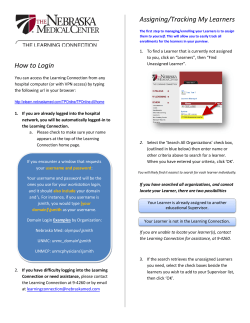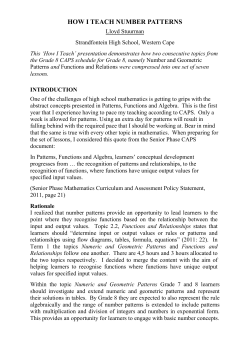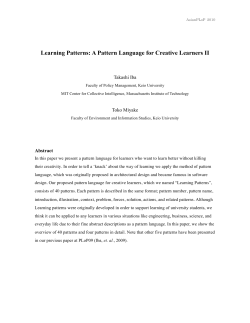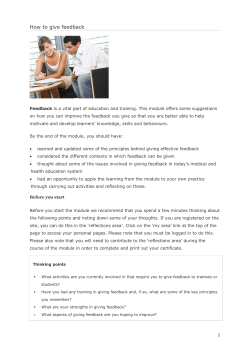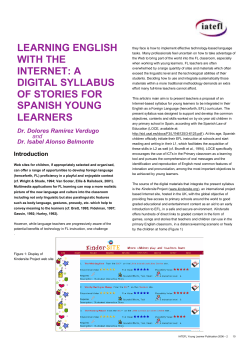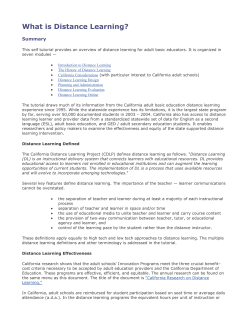
Training Adult Learners: How to Reach and Engage Your Audience
Training Adult Learners: How to Reach and Engage Your Audience Training programs are successful when learners are able to apply new knowledge to everyday workplace responsibilities. In order to ensure successful learning, agencies must develop training programs that understand and cater to their audiences– adult learners. This brief discusses the characteristics of adult learners, describes the process of learning, and provides agencies with tips on planning and delivering their training programs. It also discusses learning technologies and will recommend strategies for hosting a successful webinar. August 2012 Characteristics of adult learners Understanding your audience is one of the most important aspects of giving an effective presentation. This allows you to tailor your content, presentation style and physical environment to cater to the needs of your participants. While no two learning situations will be identical, there are overarching characteristics that are shared by most adult learners. Keeping these characteristics in mind when you plan your training curriculum will allow you to design a program that will effectively reach and engage your learners. First and foremost, adult learners are autonomous and selfdirected. Trainers should solicit participants‟ input about topics and projects that reflect their interests, and trainers should guide learners to their own knowledge rather than simply supply facts. Trainers should clearly show how the class will help participants reach their personal goals for attending. For example, if attending a particular training helps an employee qualify for a promotion, he/she should be told that at the start of the class. Adults have also accumulated years of life experience and knowledge from their workplaces, personal lives and previous education. Trainers must not only serve as a guide to knowledge, but they must also connect new learning to this previously developed knowledge/experience base. Adult learners can find it difficult to learn if the learning clashes with this previous experience or their values/beliefs. Creating a physical environment for learning The seating arrangement and physical characteristics of the training room create the environment for learning. Think about how many students will be attending, who they are and what goals you are trying to accomplish. Small round or V-shaped tables foster participation for working in small groups For presentations, U-shaped tables are preferable to round ones so all of the participants can face the front of the room For a large group with conventional auditorium seating, arrange students so that nobody has to sit directly behind another person Check the room‟s lighting and temperature, and know how to adjust both in the event that the room becomes uncomfortable Adult learners are goal and relevancy-oriented. Developing a training program that is organized and has clearly defined elements will assist them in understanding how that training will be of value. Adults are also practical, and it is important to focus on the aspects of the lesson that are most important to them as it relates to their work. Adult learners also like to be involved and favor interaction with their colleagues. They like to be challenged and have the opportunity to challenge others. Facilitated group activities and discussions are good ways to begin conversations between participants and share ideas in a safe, constructive environment. Lastly, all adult learners learn and work at different rates due to each person‟s background, experience, ability and learning style. They also use different senses to learn, and trainers should present materials that appeal to as many senses as possible to ensure they are reaching each type of learner. Each participant should be shown respect, and trainers should acknowledge the wealth of experience that adults bring to the classroom. They should be treated as equals in experience and knowledge and should be told that their opinions are valued. Adults are more likely to participate if they feel they are in a safe learning environment. Elements of the learning ‘Eco-System’ Sandra Strick, in her paper Strategies to Embrace the Adult Learner, identifies and describes the following elements of Glen Ramsborg‟s learning eco-system: 1. Physiological– we all learn using our senses. Vision is the primary sense and being able to hear is also critical. Consider temperature. Learning and attention spans decrease 6 to 10 percent for every degree the temperature goes above the comfort zone. 2. Psychological– the arrangement of the room and the color and lighting of the surroundings have a major impact on thinking, listening and concentrating. 3. Emotional– knowing the audience is critical. Learning styles, education level and the type of message being communicated have a profound impact on the individual. 4. Social/Cultural– socialization plays a significant part in the learning process. Often, the seed of learning is planted in the formal presentation and the learning comes from networking, discussing and interacting outside, such as during refreshment breaks, luncheons, team building exercises or other group activities. 5. Nutrition– the food and beverage consumed by the learner prior to and during learning activities have a remarkable affect on attention span and the ability of the learner to concentrate, learn and remember. 6. Physical– the physical arrangement of the learning space sends a message to the learner. It can encourage participation or be a distraction. The physical arrangement conveys a clear but nonverbal assumption about the learners‟ relationship with not only each other but also meeting leadership. 7. Technology– technology continues to have a significant place in the learning environment. The tendency is to forget that the learner usually comes to an event to see and hear the information the person is sharing. One does not want them to leave saying, “That was a wonderful slide show!” and miss the message. 8. Learning strategies– all put together, the type of programming developed must be appropriate for the message being communicated, the environment created and the desired outcomes. Lectures, panel discussions, group activities, or other learning strategies, must fit together as a package. The learning process Learning is accomplished not only when a participant has gained new knowledge, but when he/she is able to apply that knowledge to his/her daily tasks. Stephen Lieb, Senior Technical Writer and Planner with the Arizona Department of Health Services, identifies four critical elements that must be addressed to ensure that participants learn. These elements are motivation, reinforcement, retention and transference. Motivation: As stated in the previous section, adults are goal and relevancy-oriented. The need for the training information must be made clear in order for adult learners to be actively engaged in the lesson. Trainers can increase motivation in the classroom by setting a tone for the lesson based on the seriousness of the content and an appropriate level of difficulty based on the abilities of the learners. If the information being discussed is very important, there should be a more serious tone to the class, and students should be challenged, but not overloaded. Reinforcement: Reinforcement should be used on a regular basis to help students retain what they have learned. Positive reinforcement should be used when teaching students new skills, and it is the reinforcement of good behavior. An example of this is complimenting adult learners in front of their peers when they meaningfully contribute to the discussion. Negative reinforcement uses punishment to decrease a behavior, and this may be less effective when dealing with adult learners. An example of this would be embarrassing adult learners in front of their peers for giving an incorrect answer. Retention: Adult learners retain information better if they understand its importance and can interpret and apply the information to particular situations. The degree to which a student will retain information is also dependent on how well they were taught the information and how much practice they had during the learning. Transference: Transference is the ultimate goal of training programs– giving employees information that they are then able to apply to their daily work duties. Transference likely to occur in four situations: association, similarity, degree of original learning, and critical attribute element. Transference occurs when participants associate new information with something they already know; when the new information has a similar logical pattern or framework to previous experiences; when the information was well-understood and the degree of original learning was high; and when the information learned contains elements that are extremely critical on the job. Planning your program Before trainers can engage their students, they must plan their programs. Whether you are using a readymade training module or creating your own from scratch, how you frame and execute the material will impact how well you reach your audience. The Texas Center for the Advancement of Literacy and Learning, in its publication Learning to Listen, Learning to Teach: The Power of Dialogue in Educating Adults, presents questions that should be considered when developing a lesson plan that focuses the attention on the learner and not the teacher. Who are the learners? Why is the course or workshop needed? When is a time that is most convenient for everyone concerned? Where will the learners feel most comfortable? For what purpose is the information needed and how will learners and teachers be accountable to each other for establishing that learning has taken place? What specific information do the learners need at this time? How can a course be created that meets the needs of the learners and allows them to become proficient at using the information they learn within the time frame allowed? Delivering your program Once the program is planned, the trainer should consider how best to deliver the information. It is widely agreed that the maximum adult attention span is 15-20 minutes, and when training sessions are scheduled to be 60 to 90 minutes long, trainers must have methods for keeping learners engaged repeatedly throughout the class. Encourage physical movement Students should be given breaks throughout the course to stand up, move around, and possibly get something to eat or drink. This gives them an opportunity to network and allows them to return to the class refocused and energized. Also, a connection has been made between long-term memory and physical activity. Foster interaction Full group discussions and smaller group activities allow students to engage more actively in the lesson. This also allows students to share their skills and knowledge, and it encourages students to apply lessons to personal situations, increasing retention. Appeal to different senses Not only will this address different learning styles, but it also provides the diversity needed to combat boredom. Offer students the opportunity to see, hear and write key information. Create a safe environment Trainers can do this by establishing a friendly, open atmosphere that shows participants they are there to help the participants learn. If a student shares misinformation, address the mistake in a way that does not criticize the individual who made the comment. Trainers should give students feedback on a regular basis so they know they are on the right track and must remember that if a student‟s stress level becomes too high, that can be a barrier to learning. Learning technology Creative ways to engage your audience! For various reasons, it may not be feasible for a transit agency to conduct a traditional classroom training session for its employees. In rural areas, traditional trainings can be difficult to coordinate due to small staff sizes and reduced resources. Using learning technologies such as self-paced learning and webinars allows agencies to train their employees when time permits and to share training resources easily. Self-paced learning Self-paced learning often involves an interactive online or software program that allows a learner to use a computer to view text, videos and listen to presentations about the training topic. It can also include questions the viewer must answer along the way and a test at the end– these aspects are important for assessing how engaged a learner was with the material. This option is useful when an agency cannot find time to schedule training that works for all of their employees or when certain employees are located a long distance from where training is conducted. While more traditional styles of learning, such as presentations, small group discussions and facilitated full group discussions are an integral part of every training program, trainers can use more innovative techniques to engage their students with the material and test what students have learned. If the learners in the session do not know each other, have a short ice breaker activity at the beginning to create a sense of comfort and familiarity in the room. Holding a long training session? Break the material up with short, fun video clips. Search for “De Lijn take the bus” and “TARC bike rack rap” on YouTube. Test students‟ knowledge through group games. Microsoft PowerPoint offers different templates such as Hollywood Squares, Buzzword Bingo, Snakes and Ladders, Who Wants to be a Millionaire, and Jeopardy. When possible, conduct hands-on training that simulates the real-life situation. For example, coordinate with local fire/police departments to conduct safety training in old vehicles. Webinars Webinars are conference calls that have a visual component that shows the presentation slideshow and/or the speaker. These can be viewed in real-time and recorded for later viewing. Webinars have become very popular as trainers can reach a larger number of participants in different geographic locations without the cost of travel, time and rental space. See the following section for tips about hosting a successful webinar. While self-paced learning and webinars can be low cost, high impact training options, traditional in-person trainings are still an important way to foster learning and networking within a transit agency. “Blended learning” combines traditional methods with the use of technology, and this may be a good fit for some training programs. This involves hosting an onsite training that is followed by (or prefaced by) a webinar or self-paced learning component. Hosting a successful webinar One benefit of a webinar is that you can reach many learners in different geographic locations. However, this lack of physical interaction between the trainer and students makes it even more important for the lesson to include methods to keep the audience engaged. This section discusses tips you can use before, during and after the webinar to drive participants to your event and ensure that everyone gets the most out of the learning experience. Before the webinar Create a title for the event that not only shares the topic of the webinar but also tells why that topic matters to your audience. Make the registration form short and easy to fill out, and only ask for necessary information. Assign pre-work that includes reviewing articles, videos and other helpful information. This will get participants thinking about the topic and formulating questions. Send registrants a reminder email and use that as an opportunity to solicit questions in advance. Conduct group rehearsals to practice the presentation with everyone who will be involved. During the webinar Use a landline phone and hardwire internet connection when presenting during a webinar, and situate yourself in a room that is free of background noises and distractions. Disable all pop-up notifications on your computer, such as chat programs and email notifications. If possible, the presenter should not be the person responsible for handling the technical aspects of running the webinar. This can become distracting and complicated, especially if there is a technical difficulty during the presentation. Record the webinar for later viewing. Leave 50% of the total time for discussion, and engage the audience throughout the webinar using polling (asking the audience to respond to questions), annotations (small animations that draw attention to particular information on a slide), shared applications (sharing the presenter‟s desktop screen), videos, telephone lines for discussion and whiteboards (a screen that is up for the entire webinar where people can share notes and ideas with each other). Use the singular „you‟ when addressing the audience to make each individual feel as if you are talking directly to him/her. Smile! People will hear the change in your voice. After the webinar Send a thank you email to participants and request that they fill out a survey to provide feedback on the content and style of the presentation. Alert participants as to where they can find the recording of the webinar and when it will be available. Agencies should use the feedback from all participants (learners and presenters) to determine whether a webinar was the appropriate format for that particular information exchange. This should be done on a regular basis to assess the value of an agency‟s learning programs. Congratulate yourself on a successful webinar! Creating positive and productive learning experiences A great deal of time and resources are required to plan and conduct training sessions, and because of this it is important to ensure that every training program is making the greatest impact possible. Creating a curriculum that is tailored to reaching and engaging adult learners is the first step to a successful training program. Focusing on creating a welcoming atmosphere, dynamic physical space, interactive presentation style, and content appropriate for your audience will take a training program from good to great. Whether your learners are all in the same classroom or scattered geographically on a webinar, using the tips included in this brief will help you create a positive and productive learning experience for everyone involved! Sources and Helpful Resources Adobe, Best Practices for Webinars, white paper http://www.adobe.com/products/acrobatconnectpro/webconferencing/pdfs/Best_Practices_for_Webinars_v4_FINAL. pdf Edwards, Kathleen, Get Interactive! Ensure Your Webinar Speakers Engage Their Learners, Compass Points http://learningevangelist.com/wp-content/uploads/2010/12/article-for-KRM-engagement-final.pdf Lieb, Stephen, Principles of Adult Learning http://carrie-e.startlogic.com/handouts/Rotterdam2012/Eu_Coaches_Conf2_Rott_Day_1_A4.pdf Maine Commission for Community Service, Best Practices for Interactive Webinars http://www.nationalserviceresources.org/files/webinar-planning-advice.pdf National RTAP, Essential Skills for Trainers www.nationalrtap.org Pixion, Best Practices in Webinars, white paper http://www.picturetalk.com/webinar_bestpractices.pdf Strick, Sandra, Strategies to Embrace the Adult Learner, Professional Meeting Management Guidebook, fifth edition http://pcma.org/Documents/adultlearningprinciples.pdf TechSoup, 10 Steps for Planning a Successful Webinar http://www.techsoup.org/learningcenter/training/page11252.cfm Vella, Jane, Learning to Listen, Learning to Teach: The Power of Dialogue in Educating Adults, Texas Center for the Advancement of Literacy and Learning http://www-tcall.tamu.edu/research/studygroup/studygroup.pdf A program of the Federal Transit Administration administered by the Neponset Valley Transportation Management Association
© Copyright 2025


